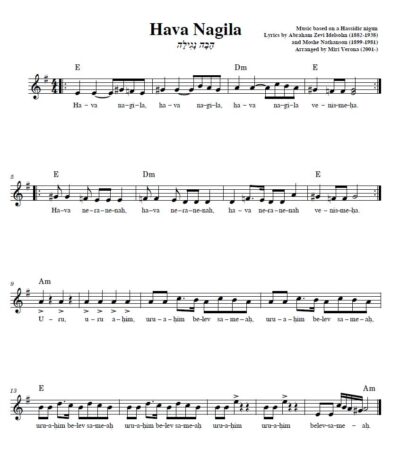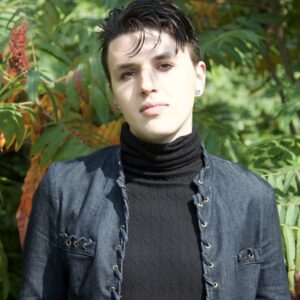Welcome back to campus! Now that you’ve had your fall semester orientation, our magazine is offering up an alternative education: The New Voices Disorientation Guide, where Jewish student activists and organizers give the low down on today’s hot-button campus issues, including the tips and tricks that university administration might not want you to know. Read more Disorientation Guide articles here.
My band had been worried all day because there was a chance it would storm and our set would be canceled. This was our first big performance and our first paid gig at our college’s music festival: a whopping $100 split among the nine of us. Our excitement had ramped up as posters advertised our band name, “The Klezmommies,” along with up-and-coming artists from off-campus.
As we took the stage for our sound check before playing, some of our closest friends had walked into the audience with a huge yellow banner reading “That’s my Klezmommy,” matching the custom yellow shirts we’d designed and sold to friends. The weather was clear as we started playing for the large crowd on the grass in front of us.
Half-way through, we played our chaotic rendition of “Hava Nagila.” I took the mic to intone a raspy cantorial intro before queuing the band to start playing with a leap and jerk of my fist in the air. I skipped back to the keyboard to find our lead singer had given away my chair to the crowd.
I haphazardly started laying down messy chords crouched over the piano as the same friend in the crowd started a circle to dance the hora. My missing chair had found its way to the center of the circle where four folks started lifting up other audience members in the style of a b’nei mitzvah. Two or three circles spiraled around the lifted chair as it began to rain. But nobody stopped dancing; the show went on.
This successful first set continues to inspire me to encourage more and more people to play klezmer. Here’s the advice I wish I’d have had before I started figuring out how to quench my thirst for the genre. Learning about klezmer was an uphill battle for me, as all I had were books, recordings and the internet to start learning about the tradition. Klezmer is powerful, and its complex beauty should be accessible to all young Jews who want to play.
What is klezmer?
First things first, what is klezmer? The name of this genre of music comes from the Hebrew words כְּלִי (k’lí) and זֶמֶר (zémer), which mean tool or instrument and melody or song respectively. It’s important to foreground the genre with this Hebrew etymology because while not all Jewish music is klezmer, all klezmer is Jewish music.
Traditionally, klezmer refers to an Ashkenazi musical tradition that emerged largely in Eastern Europe and migrated to America along with the Jews who played it. Though the American klezmer scene coalesced along with Jewish immigration in the late 19th and early 20th centuries, the “Klezmer Revival” began in the 1970s, where American-Jewish musicians revitalized the genre that was at risk of fading away.
In a modern context, klezmer isn’t just a genre, it’s an idiom. Think of jazz: just as jazz includes discrete, specific styles as well as a rich history and tradition coming from the African diaspora and African-American cultures, many different things just sound “jazzy.” So too with klezmer in a broadly Jewish diasporic or Ashkenazi context: many things could be klezmer, but sometimes it just sounds “klezzy.”
Finding your people
Finding people to play with you might be the most difficult part of your journey. I recommend adherence to what I call the “Hava Nagila Principle”: when in doubt, air on the side of accessibility.
Open-mindedness and sincere passion are two key ingredients to any successful musical experience, so feel no shame if you need to start by playing something well-known to the point of clichè which some might not even consider to be truly klezmer like “Hava Nagila”. Simple and singable tunes like ‘Hava’ are great because they also invite more casual musicians and music appreciators into the fray. Your fellow musicians may not all be Jewish; not all of mine are. What’s important is their respect for Jewish culture and a willingness to listen.

But where to look for bandmates? If your university has them, your music school and Hillel will be two incredibly important resources to gauge interest. Reach out to any musicology, music performance, or even Jewish studies professors who might support you or have a background in klezmer or Jewish music. They may also know of other students to connect you to. The more comfortable you are wearing your passion on your sleeve, the easier it will be to find your people.
Once I found enough interested musicians, I started hosting open jams which eventually led to the formation of our 9-member group. Klezmer isn’t very well known, so gauging interest might feel discouraging. If you remain steadfast in your passion and maintain healthy communication with the musicians around you, you can better understand what direction you can go in and what direction everyone wants to go in. Your group might want to just have a weekly low-stakes jam for fun or maybe you’ll find companions who are ready to rehearse 5 times a week to start your earth-shattering avant-prog electronica klezmer supergroup.
How to rehearse
With committed musicians and rehearsal times in place, you’ll need to decide songs to play, which can be tough. If you’re looking to get started, give this playlist a listen. Ask your peers for their ideas and, again, defer back to the Hava Principle if you’re in doubt. Start basic, with room to build. My bandmates and I have grown an incredible amount as klezmer musicians over the past year; much of the stuff we play now with ease would’ve been a huge ask if I brought them to our seminal jam where I struggled to fumble out chords on a piano.
I tend to learn songs on piano and make my own sheet music for them, but using one of the many Jewish or klezmer sheet music books is just as acceptable. They’re easy to buy online (for example, here, here, and here). It’s important to listen to recordings of the music you play – this can even be helpful during a rehearsal as a group exercise. The intention is not to copy recordings exactly, but rather sharing a point of inspiration and feeling the music inside your body as you read it off the sheet.
Check out these two recordings of Hava Nagila by the Barry Sisters and the Klezmer Lounge Band:
My band’s rehearsals are quite intuitive at this point. None of us, myself least of all, want me as a strict bandleader, so while we all have a shared sense of gigs and performance commitments, we all mostly want to have fun as a group. If we have fun playing, usually our audience will too. That’s all we can ask for.
Getting gigs and performing
My band’s first gig was our Hillel’s Hanukkah party. At a certain point, we’d jammed out on a handful of songs so many times that we realized they were “performance-ready.” There was nothing meticulous about the performance, it was really another example of the Hava Principle: we could play the songs comfortably and have fun, so it was accessible to our first audience: a room of our friends from Hillel.
A cozy Hillel gathering or just planning your own informal living room concert for your friends are great opportunities for an undaunting and low-stakes first performance. After that, you can go further and look into more formal performance venues. Each opportunity has a different set of expectations, so you may designate different administrative tasks among musicians, such as who can drive, who can find rehearsal spaces, who can communicate with event coordinators, etc. Over time, you’ll also refine your set of songs to be appropriate for each performance.
Find local festivals, especially folk music or Jewish arts festivals or music festivals hosted by your university, and reach out to the organizers. Plenty of music outreach programs exist where you can play for children, seniors, the homeless, and various other groups who host entertainers and bands. Local synagogues are also great to reach out to, where you might be able to play for services, use the synagogue as a performance or rehearsal space, or make connections in the local Jewish community to play for weddings or b’nai mitzvahs.
As a general rule, the further in advance you can reach out about events, the better – both for you and your hosts. Not all organizations, festivals or opportunities will have the funds or willingness to pay your group, but it never hurts to ask. Especially if you’re providing music for an event like a wedding or temple service and you are being asked to rehearse and play specific music for such an event, it’s reasonable to expect compensation.
Why play klezmer?
When our set ended, my bandmates and I exchanged gleeful looks and sopping hugs as friends in the audience came to do the same. When we returned, our friend selling our merch shirts told us the 50 we’d ordered were sold out, some on the backs of people I’d never even met. I smiled that day more than I had in years. I realized just how important klezmer music was to me and how I wanted to shout my love for this music to the world.
That day, klezmer brought together Jews and Gentiles on our campus to dance. Our band’s presence bred positivity between the Jewish and broader campus community like I’d never known at our college, in this medium-sized Midwestern city that boasts a 0.12% Jewish population. It gave me hope.
I think back to jazz, a genre which holds an incredibly well-deserved (and complicated!) place in our music culture. It provides us not only with undeniably amazing and forward-thinking music, but also space to have difficult discussions about identity and culture. I think klezmer provides a similar meaning for us.
We live in polarizing times. Whether the antisemitism is veiled or not, it doesn’t help the alienation we as Jews already feel in a society where we don’t know who to trust and around whom we can embrace our identities. But klezmer can build that bridge. I want more people to play klezmer music because it is my ideal of Jewish joy. Klezmer can provoke deep conversation, it makes you want to dance, but maybe most importantly, can make you smile. It’s undeniable and it’s Jewish, but it’s for you and for me.
Featured image: The Klezmommies perform during LUaroo on Main Hall Green May 29, 2022. Photo by Danny Damiani.

